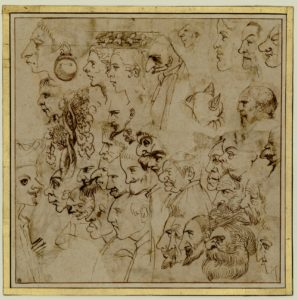We all doodled and scribbled during school. Animals or 3D cubes or, if you’re a nineties kid like me, the Superman S covered the inside covers of notebooks and in the margins of notepaper. A new exhibition at a museum in Rome is now open to highlight and elevate the art of the doodle by showing that everyone does it, especially some of history’s greatest artists.
Scribbling & Doodling at the Academie de France, located at the Villa Medici in Rome, is the assembly of one hundred fifty works spanning centuries to show that even the greatest artists make little, meaningless scribbles in notebooks or even on the backs of masterpieces. Curators refer to the exhibition’s subject as “one of the most unconventional and overlooked aspects of the practice of drawing.” Without any attention to chronology, genre, or subject, the works of old masters like Michelangelo, Gianlorenzo Bernini, and Leonardo da Vinci hang alongside those of modern masters like Jean-Michel Basquiat, Pablo Picasso, and Cy Twombly. The exhibition features pieces from the Louvre and the Petit Palais Museum in Paris, the Uffizi and the Accademia Galleries in Florence, the Staatliche Museum in Berlin, and the National State Archives in Rome, among many others.
One of the exhibit’s centerpieces is a triptych by the Renaissance master Giovanni Bellini. While the panels are normally arranged against a wall at Florence’s Galleria dell’Accademia, here they are on stands in the middle of the gallery. This allows visitors to view the triptych in the round, revealing dozens of drawings on the wooden back ranging from figures in profile to demonic faces. Eugene Delacroix’s childhood notebooks, Cy Twombly’s sketches, and caricatures by Antonio Caracci are just a few of the featured works at the Villa Medici.
It’s thought-provoking to have an entire exhibition dedicated to a form of art that is often considered unintentional, meant only for the artist’s amusement. Yet the curators acknowledge the role that spontaneous sketches and scribbles have played in the development of twentieth-century art. Many modern masters have consistently turned back to childhood to reach a purer artistic style than whatever was taught at stuffy art schools in the world’s great cities. Picasso himself admitted, “It took me four years to paint like Raphael, but a lifetime to draw like a child.” And so visitors are invited to unleash their own inner child. One of the final rooms is painted completely gray, while visitors are given writing implements to use at their leisure. Scribbling & Doodling will be on display until May 22nd before moving to the Beaux-Arts in Paris for an exhibition starting on October 19th.

